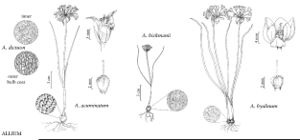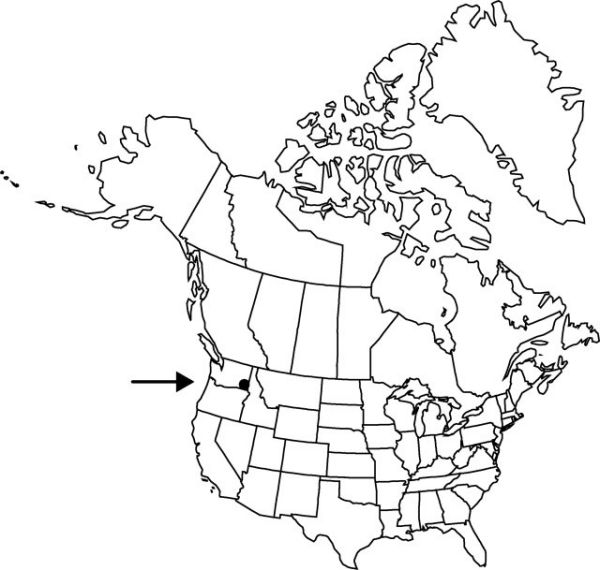Allium dictuon
Proc. Biol. Soc. Wash. 50: 3, fig. 1. 1937.
Bulbs usually solitary, forming rhizomes; rhizomes 1–2, terminated by 1–3 new bulbs, short, slender; parent bulb disappearing by anthesis except for still-functional roots and bulb coats, not basally clustered, oblique-ovoid, 1–1.5 × 0.9–1.5 cm; outer coats not enclosing bulbs, pale brown, prominently cellular-reticulate, membranous, cells polygonal to oblong, walls thick, obscurely sinuous, without fibers; inner coats white, cells ± transversely elongate, intricately contorted. Leaves persistent, withering from tip by anthesis, 2–3, basally sheathing, sheaths not extending much above soil surface; blade solid, subterete to ± channeled, 10–28 cm × 1–2 mm, margins entire. Scape persistent, solitary, erect, solid, terete, 20–40 cm × 1–3 mm. Umbel persistent, erect, loose, 10–25-flowered, hemispheric, bulbils unknown; spathe bracts persistent, 2, 3-veined, lanceolate to lance-ovate, ± equal, apex acuminate. Flowers campanulate, 11–16 mm; tepals erect, pink to rose-purple, lanceolate, unequal, outer tepal longer and wider than inner, becoming rigid and keeled in fruit, margins finely denticulate (inner tepal more prominently so), apex acute to narrowly obtuse, becoming involute and appearing long-acuminate, flaring toward tips; stamens included; anthers yellow; pollen yellow; ovary crested; processes 3, central, 2-lobed, rounded, minute, margins entire; style linear, equaling stamens; stigma capitate, scarcely thickened, obscurely 3-lobed; pedicel 10–25 mm. Seed coat shining; cells minutely roughened. 2n = 14.
Phenology: Flowering Jun–Jul.
Habitat: Rocky, sandy, basaltic soil
Elevation: 1500 m
Discussion
Of conservation concern.
Allium dictuon is known only from the vicinity of Weller’s Butte, Blue Mountains. It differs from A. acuminatum by its rhizomatous habit, in which it resembles A. bolanderi, and in the cellular pattern on the inner bulb coats.
Selected References
None.

